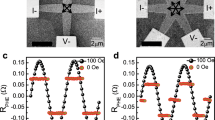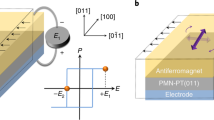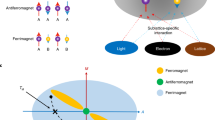Abstract
Exchange bias, a shift in the hysteresis loop of a ferromagnet arising from interfacial exchange coupling between adjacent ferromagnetic and antiferromagnetic layers, is an integral part of spintronic devices. Here, we show that spin–orbit torque generated from spin current, a promising approach to switch the ferromagnetic magnetization of next-generation magnetic random access memory, can also be used to manipulate the exchange bias. Applying current pulses to a Pt/Co/IrMn trilayer causes concurrent switching of ferromagnetic magnetization and exchange bias, but with different underlying mechanisms. This implies that the ferromagnetic magnetization and exchange bias can be manipulated independently. Our work demonstrates that spin–orbit torque in ferromagnet/antiferromagnet heterostructures facilitates independent manipulations of distinct magnetic properties, motivating innovative designs for future spintronics devices.
This is a preview of subscription content, access via your institution
Access options
Access Nature and 54 other Nature Portfolio journals
Get Nature+, our best-value online-access subscription
$29.99 / 30 days
cancel any time
Subscribe to this journal
Receive 12 print issues and online access
$259.00 per year
only $21.58 per issue
Buy this article
- Purchase on Springer Link
- Instant access to full article PDF
Prices may be subject to local taxes which are calculated during checkout




Similar content being viewed by others
Data availability
The data that support the findings of this study are available from the corresponding author upon reasonable request.
References
Nogués, J. & Schuller, I. K. Exchange bias. J. Magn. Magn. Mater. 192, 203–232 (1999).
Berkowitz, A. E. & Takano, K. Exchange anisotropy—a review. J. Magn. Magn. Mater. 200, 552–570 (1999).
Zhang, W. & Krishnan, K. M. Epitaxial exchange-bias systems: from fundamentals to future spin-orbitronics. Mater. Sci. Eng. R. Rep. 105, 1–20 (2016).
Meiklejohn, W. H. & Bean, C. P. New magnetic anisotropy. Phys. Rev. 105, 904–913 (1957).
Radu, F. et al. Origin of the reduced exchange bias in an epitaxial FeNi(111)/CoO(111) bilayer. Phys. Rev. B 79, 184425 (2009).
Gruyters, M. & Schmitz, D. Microscopic nature of ferro- and antiferromagnetic interface coupling of uncompensated magnetic moments in exchange bias systems. Phys. Rev. Lett. 100, 077205 (2008).
Miron, I. M. et al. Current-driven spin torque induced by the Rashba effect in a ferromagnetic metal layer. Nat. Mater. 9, 230–234 (2010).
Miron, I. M. et al. Perpendicular switching of a single ferromagnetic layer induced by in-plane current injection. Nature 476, 189–193 (2011).
Liu, L. et al. Spin–torque switching with the giant spin Hall effect of tantalum. Science 336, 555–558 (2012).
Liu, L., Lee, O. J., Gudmundsen, T. J., Ralph, D. C. & Buhrman, R. A. Current-induced switching of perpendicularly magnetized magnetic layers using spin torque from the spin hall effect. Phys. Rev. Lett. 109, 096602 (2012).
Pai, C.-F. et al. Spin transfer torque devices utilizing the giant spin Hall effect of tungsten. Appl. Phys. Lett. 101, 122404 (2012).
Cubukcu, M. et al. Spin–orbit torque magnetization switching of a three-terminal perpendicular magnetic tunnel junction. Appl. Phys. Lett. 104, 042406 (2014).
Safeer, C. K. et al. Spin–orbit torque magnetization switching controlled by geometry. Nat. Nanotechnol. 11, 143–146 (2016).
Fukami, S., Anekawa, T., Zhang, C. & Ohno, H. A spin–orbit torque switching scheme with collinear magnetic easy axis and current configuration. Nat. Nanotechnol. 11, 621–625 (2016).
Qiu, X. et al. Spin–orbit-torque engineering via oxygen manipulation. Nat. Nanotechnol. 10, 333–338 (2015).
Huang, K.-F., Wang, D.-S., Tsai, M.-H., Lin, H.-H. & Lai, C.-H. Initialization-free multilevel states driven by spin–orbit torque switching. Adv. Mater. 29, 1601575 (2017).
Baumgartner, M. et al. Spatially and time-resolved magnetization dynamics driven by spin–orbit torques. Nat. Nanotechnol. 12, 980–986 (2017).
Lee, O. J. et al. Central role of domain wall depinning for perpendicular magnetization switching driven by spin torque from the spin Hall effect. Phys. Rev. B 89, 024418 (2014).
Van den Brink, A. et al. Field-free magnetization reversal by spin–Hall effect and exchange bias. Nat. Commun. 7, 10854 (2016).
Rojas-Sánchez, J. C. et al. Perpendicular magnetization reversal in Pt/[Co/Ni]3/Al multilayers via the spin–Hall effect of Pt. Appl. Phys. Lett. 108, 082406 (2016).
Nunez, A. S., Duine, R. A. & MacDonald, A. H. Antiferromagnetic metal spintronics. Phil. Trans. R. Soc. A 369, 3098–3114 (2011).
Jungwirth, T., Marti, X., Wadley, P. & Wunderlich, J. Antiferromagnetic spintronics. Nat. Nanotechnol. 11, 231–241 (2016).
He, X. et al. Robust isothermal electric control of exchange bias at room temperature. Nat. Mater. 9, 579–585 (2010).
Wu, S. M. et al. Reversible electric control of exchange bias in a multiferroic field-effect device. Nat. Mater. 9, 756–761 (2010).
Oh, Y. W. et al. Field-free switching of perpendicular magnetization through spin–orbit torque in antiferromagnet/ferromagnet/oxide structures. Nat. Nanotechnol. 11, 878–884 (2016).
Kong, W. J. et al. Field-free spin Hall effect driven magnetization switching in Pd/Co/IrMn exchange coupling system. Appl. Phys. Lett. 109, 132402 (2016).
Wu, D. et al. Spin–orbit torques in perpendicularly magnetized Ir22Mn78/Co20Fe60B20/MgO multilayer. Appl. Phys. Lett. 109, 222401 (2016).
Fukami, S., Zhang, C., Duttagupta, S., Kurenkov, A. & Ohno, H. Magnetization switching by spin–orbit torque in an antiferromagnet–ferromagnet bilayer system. Nat. Mater. 15, 535–541 (2016).
Du, C., Wang, H., Yang, F. & Hammel, P. C. Systematic variation of spin–orbit coupling with d-orbital filling: Large inverse spin Hall effect in 3d transition metals. Phys. Rev. B 90, 140407 (2014).
Pham, T. H. et al. Thermal contribution to the spin–orbit torque in metallic–ferrimagnetic systems. Phys. Rev. Appl. 9, 064032 (2018).
Zhang, W. et al. Spin Hall effects in metallic antiferromagnets. Phys. Rev. Lett. 113, 196602 (2014).
Zhang, W. et al. All-electrical manipulation of magnetization dynamics in a ferromagnet by antiferromagnets with anisotropic spin Hall effects. Phys. Rev. B 92, 144405 (2015).
Ghosh, A., Auffret, S., Ebels, U. & Bailey, W. E. Penetration depth of transverse spin current in ultrathin ferromagnets. Phys. Rev. Lett. 109, 127202 (2012).
Zhang, J., Levy, P. M., Zhang, S. & Antropov, V. Identification of transverse spin currents in noncollinear magnetic structures. Phys. Rev. Lett. 93, 256602 (2004).
Daalderop, G. H. O., Kelly, P. J. & DenBroeder, F. J. A. Prediction and confirmation of perpendicular magnetic anisotropy in Co/Ni multilayers. Phys. Rev. Lett. 68, 682–685 (1992).
Kim, J. et al. Layer thickness dependence of the current-induced effective field vector in Ta|CoFeB|MgO. Nat. Mater. 12, 240–245 (2013).
Garello, K. et al. Symmetry and magnitude of spin–orbit torques in ferromagnetic heterostructures. Nat. Nanotechnol. 8, 587–593 (2013).
Lee, K.-S., Lee, S.-W., Min, B.-C. & Lee, K.-J. Threshold current for switching of a perpendicular magnetic layer induced by spin Hall effect. Appl. Phys. Lett. 102, 112410 (2013).
Vallobra, P. et al. Manipulating exchange bias using all-optical helicity-dependent switching. Phys. Rev. B 96, 144403 (2017).
Mishra, R. et al. Anomalous current-induced spin torques in ferrimagnets near compensation. Phys. Rev. Lett. 118, 167201 (2017).
Qiu, X. et al. Enhanced spin–orbit torque via modulation of spin current absorption. Phys. Rev. Lett. 117, 217206 (2016).
Freitas, P. P., Ferreira, R. & Cardoso, S. Spintronic sensors. Proc. IEEE 104, 1894–1918 (2016).
Acknowledgements
This work was partially supported by the Ministry of Science and Technology of Republic of China under Grant No. MOST 107-2218-E-007-024, MOST 106-2221-E-007-037-MY2 and MOST 106-2112-M-007-011-MY3. The authors thank Prof. Po-Tsun Liu, Prof. Ting-Chang Chang and Keithley Instruments Taiwan for the help on TRRM measurement.
Author information
Authors and Affiliations
Contributions
P.-H.L., B,-Y,Y., M.-H.T. and K.-F.H. designed the experiments and measurements. P.-H.L., B,-Y,Y., M.-H.T. and P.-C.C. made the samples. H.-H.L. and C.-H.L. constructed the explanation of phenomenon for the exchange-bias switching by SOT; P.-H.L., B.-Y. Y., M.-H.T., H.-H.L. and C.-H.L. discussed and finished the manuscript. All authors provided the suggestions on the results and revized the manuscript.
Corresponding authors
Ethics declarations
Competing interests
The authors declare no competing interests.
Additional information
Publisher’s note: Springer Nature remains neutral with regard to jurisdictional claims in published maps and institutional affiliations.
Supplementary information
Supplementary Information
Supplementary Figures 1–17, Supplementary Table 1, Supplementary Notes 1–12, Supplementary References 1–9
Rights and permissions
About this article
Cite this article
Lin, PH., Yang, BY., Tsai, MH. et al. Manipulating exchange bias by spin–orbit torque. Nat. Mater. 18, 335–341 (2019). https://doi.org/10.1038/s41563-019-0289-4
Received:
Accepted:
Published:
Issue Date:
DOI: https://doi.org/10.1038/s41563-019-0289-4
This article is cited by
-
Self-assembly of Co/Pt stripes with current-induced domain wall motion towards 3D racetrack devices
Nature Communications (2024)
-
Intrinsic exchange biased anomalous Hall effect in an uncompensated antiferromagnet MnBi2Te4
Nature Communications (2024)
-
Room temperature energy-efficient spin-orbit torque switching in two-dimensional van der Waals Fe3GeTe2 induced by topological insulators
Nature Communications (2023)
-
Field-free spin-orbit torque switching assisted by in-plane unconventional spin torque in ultrathin [Pt/Co]N
Nature Communications (2023)
-
Electrical manipulation and detection of antiferromagnetism in magnetic tunnel junctions
Nature Electronics (2023)



